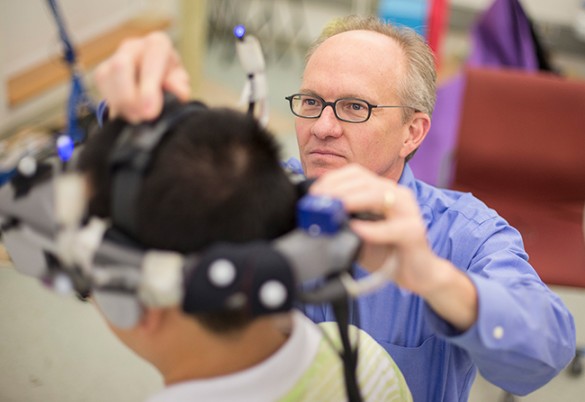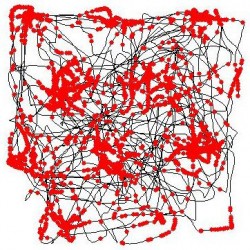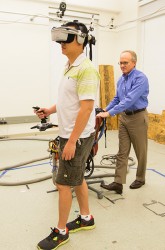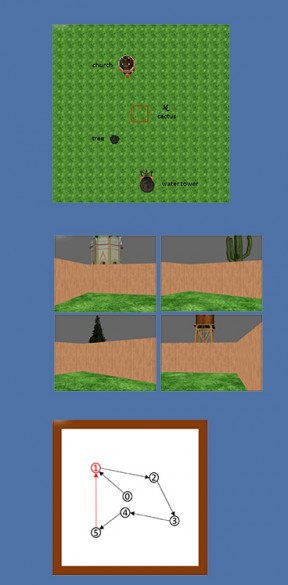
As everyone who has gotten up in the middle of the night to go to the bathroom knows, the brain maintains a sense of place and a basic ability to navigate that is independent of external clues from the eyes, ears and other senses.
A series of immersive virtual reality experiments has now confirmed that the human brain’s internal navigation system works in the same fashion as the grid cell system, a specialized neural network discovered in rats only 10 years ago, which has since been identified in a number of other mammals, including mice, bats and monkeys.
The experiments were performed by a research team headed by Timothy McNamara, professor of psychology at Vanderbilt University, and described in the June 29 issue of the journal Current Biology.
Questions about the brain’s ability to navigate have engaged philosophers and scientists for a long time. For example, the 18th-century philosopher Immanuel Kant argued that perception of place was an innate ability independent of experience. In 1948, American experimental psychologist Edward Tolman proposed that the brain must maintain a map-like representation of its surroundings.
But it wasn’t until the 1970s that an English scientist, John O’Keefe, found where this map-like representation was hidden in the brain when he discovered the existence of “place cells” in the hippocampus. Place cells are specialized neurons that become active whenever a free-roaming rat reaches a specific location in its environment. Because different place cells become active when the animal is in different places, large numbers of these cells could provide the basis of the spatial representation Tolman had proposed.

In 2005, a team of Norwegian scientists headed by Edvard and May-Britt Moser discovered that place cells were only one part of a more sophisticated system that not only serves as the basis for spatial memory, but also gives individuals their basic navigational sense. It is called the grid cell system and is located in a narrow strip of tissue on the bottom of the brain called the entorhinal cortex. The EC acts as the main interface between the hippocampus and the neocortex.
By tracing connections from the place cells in the hippocampus to the EC and by moving their rats from small cages to larger enclosures, the Mosers discovered a set of neurons with an astonishing firing pattern. Instead of becoming active at the single location like place cells, they became active at several locations. When rats were allowed to explore these large enclosures for extended periods of time, it became apparent that the locations at which a particular grid cell was active formed a remarkably regular grid-like pattern, similar to honeycomb. As a result, they were named grid cells.
In 2014, O’Keefe and the Mosers received the Nobel Prize in Physiology or Medicine for their discoveries.

Since grid cells were identified in animals, researchers have found circumstantial evidence that humans have a similar navigation system. For example, direct recordings of nerve activity in the brains of patients with epilepsy during pre-surgical investigations have found evidence for place-like cells in the hippocampus and grid-like cells in the EC. However, other experiments, which found that individuals with damage to their hippocampus and EC can maintain their sense of direction while blindfolded, have raised questions about the extent to which humans depend on this part of the brain to navigate.
McNamara and his collaborators – Vanderbilt doctoral students Xiaoli Chen and Qiliang He, Jonathan Kelly from Iowa State University and Ila Fiete from the University of Texas, Austin – became interested in a series of experiments where the researchers had recorded how the rat’s grid cell system responds when the size of its enclosure is altered. The researchers who performed the experiments found that the grid spacing increased when the enclosure was enlarged and decreased when the enclosure shrunk.
The activity of individual grid cells does not identify specific locations by themselves. But seven years ago, Fiete showed mathematically that the activity patterns of collections of grid cells could be translated into unique spatial positions.
McNamara realized that they could perform some similar experiments for human participants using immersive virtual reality and apply Fiete’s model to see if the human navigation system operates in the same fashion as a grid-cell system.

Specifically, the researchers created virtual enclosures of different sizes, had participants walk to a series of way markers (colored columns of light that appear one at a time and disappear when a participant reaches them), blanked out their view, asked them to find their way directly back to the first marker and recorded how close they came to its position. The first few trials were conducted in an enclosure that remained the same size. For the final trial, however, they changed one of the dimensions by as much as 40 percent.
“In most cases, the participants don’t even notice that the size of the enclosure has changed,” McNamara said. “But, when it does change, the positions where they stop are significantly farther from the target than they are when the enclosure remains the same. When the enclosure increases in size they tend to undershoot, and when it decreases they tend to overshoot.”
The amounts that the participants undershot and overshot were remarkably consistent with what the studies with rats and Fiete’s model predicted if the individuals were being guided by a grid-cell system that had been fixed by the dimensions of the original enclosure.
“We still can’t say for certain that people use a grid-cell system to navigate,” McNamara said. “But we can say that if people use a different system, it seems to behave in exactly the same way.”
The research was supported by National Science Foundation grants HCC 0705863, MRI 0821640, EAGER 1148973 and the Office of Naval Research grant N000141310529.